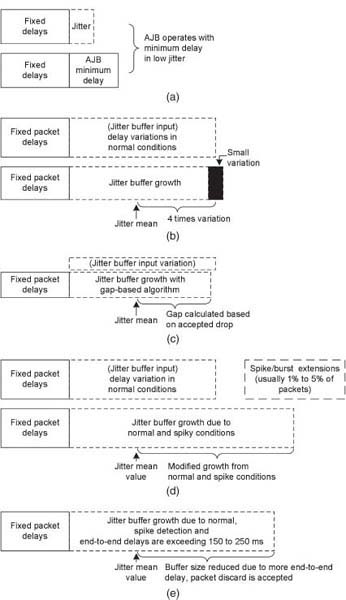10.6 ADAPTING TO DELAY VARIATIONS
Figure 10.6 is an expanded version of Fig. 10.5(b) with a few more example steps of various jitter buffer algorithms and their role in arriving at optimal jitter buffer settings. Jitter buffer algorithms at a high level are expanded in the next section.
- In Fig. 10.6(a), jitter is shown as very minimal and AJB will just stay with the minimum set delay.
- In Fig. 10.6(b), large jitter is present that is more than the AJB minimum threshold. AJB will start increasing its threshold to accommodate almost all available packets. The jitter is marked as normal—which means jitter is not a sudden spike. In this situation, algorithms that estimate mean variation will serve the purpose of setting the playout or AJB buffer size. The buffer size usually keeps changing with time in the process of optimization of end-to-end delay. A small variation can be observed in the buffer growth as marked in Fig. 10.6(b).
- In Fig. 10.6(c), a gap-based algorithm explained in Section 10.7.6 is marked. The algorithms based on mean value, variation and catering to spike conditions are not provisioned for monitoring what percentile of packets are played out in the AJB adjustments. The gap-based scheme works for the desired goals of packet drop. To meet the packet drop goals, jitter buffer may also increase or decrease significantly.

Figure 10.6. Basics on AJB adjustments. (a) AJB ...
Get VoIP Voice and Fax Signal Processing now with the O’Reilly learning platform.
O’Reilly members experience books, live events, courses curated by job role, and more from O’Reilly and nearly 200 top publishers.

